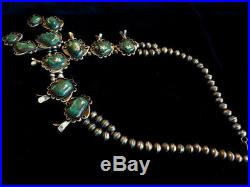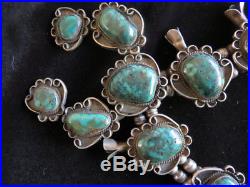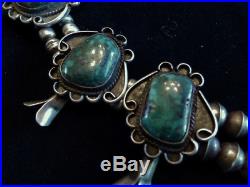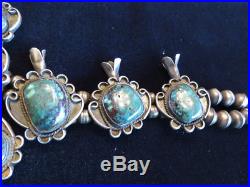




This beauty originally came from an estate in Maine. It is vintage sterling silver & Royston Mine turquoise (Nevada), from the 40s or 50s. It has attained a very nice patina over the years. It is 22-1/2 long and weighs 124g. The naja is 2-1/2″ tall & 2-3/4″ wide. Actually, both measurements are just a tiny smidge over those. The blossoms vary some, but all are in the ranges of. TALL: 1-1/2″, 1-5/8″, 1-3/8. WIDE: 1″, 1-1/8″ wide, and so forth. I couldnt find a signature, but that is often sadly the case with older pieces. Photographing any turquoise appears to be QUITE DIFFICULT, so I tried to match the basic overall color of the stones to real-life Pantone chips. Please bear in mind that monitors differ in their color presentation. The three colors in these stones basically match a combination of Pantone 561C, 562C & 563C. I adjusted the stones to try & reflect their true color more closely, and that may have resulted in a change to the color of the silver. The metal color in this piece is regular patinad silver in real life, nothing unusual about the color. It is up to every owner, of course, as to whether or not to clean Native American jewelry like this that has acquired a lovely patina. I was told many years ago that you should not fully clean this type of jewelry, as it decreases the value somewhat. Patinas will come back, however. Cleaning the back of the naja, however, might be a good idea before wearing it unless you wear black. Hand Rolled Silver Beads & Navajo Pearls. Creating hand-rolled silver beads, sometimes called Navajo Pearls, is a celebrated tradition among Navajo silversmiths and an icon of Navajo jewelry. The artist begins with two flat discs of silver then shapes them into domes using a dapping punch. The halves are soldered together and filed to form a beautiful silver bead. Usually formed from heavy gauge sterling silver, the beads may be smooth, stamped, fluted, slightly flattened or round and polished. Making hand-rolled beads is an extremely labor-intensive process but it creates one of the most beautiful and recognized necklace styles in the world. The squash blossom necklace is a bold statement piece that represents a storied legacy of jewelry-making by Native Americans of the Southwest. The central inverted crescent, called a naja, was an ornament that the Spanish used on horse bridles and may have originally come from Moorish designs. Fluted blossoms were another silver ornament used by Spanish and Mexican people to embellish their clothing. Possibly derived from European pomegranate flowers, this decorative shape was called a squash blossom by Navajo silversmiths. Silver beads were introduced to North American by Europeans and by the 19th century had long been prized by the Navajo and other Southwestern Native cultures. When Navajo artisans first learned silversmithing in the 1850s, these beads became a staple of Navajo jewelry. The first squash blossom necklace was created around 1880, blending these three elements into a distinctive and enduring form. Today, the squash blossom necklace is an icon of Native American and Southwestern jewelry and one of the most recognized types of jewelry in the world. Though it is an emblem of Southwestern style, it has been embraced by American fashion designers, making its way into high fashion. One of the most valuable and collected forms of Southwestern Native art, squash blossom necklaces are timeless heirlooms that will be enjoyed for generations. The item “Sterling Silver Royston Turquoise Squash Blossom Necklace” is in sale since Monday, August 6, 2018. This item is in the category “Jewelry & Watches\Ethnic, Regional & Tribal\Native American\Necklaces & Pendants”. The seller is “shawlerinc” and is located in Greenbrae, California. This item can be shipped to United States.
- Jewelry Type: Necklaces
- Main Stone: Turquoise
- Metal: Sterling Silver
